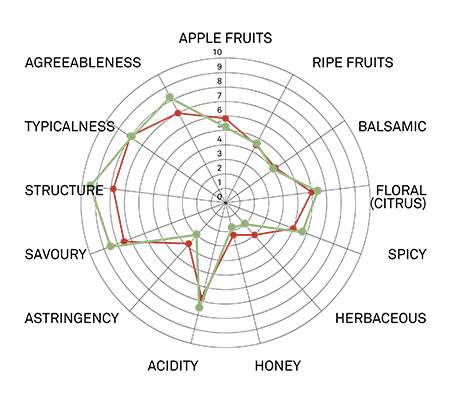
Verdicchio
Vine of ancient origin, already known in Roman times, cultivated mainly in the Marche region, sporadically in the neighbouring regions. Widely known as Trebbiano di Soave or Lugana in the Garda Lake area and the Verona and Brescia provinces.
CULTIVATED AREA IN ITALY
|
YEAR |
1970 |
1982 |
1990 |
2000 |
2010 |
|
AREA OF VERDICCHIO |
3.863 | 3.831 | 3.919 | 3.714 | 2.300 |
| AREA OF TREBBIANO DI SOAVE AND TREBBIANO DI LUGANA | 1.693 | 1.993 | 2.368 | 1.803 | 950 |
Bud-burst period:everage-late.
Ripening period:everage-late.
Yield: good and relatively constant.
Ampelographic characters:
the variety is relatively homogeneous; the differences are about bud vigour and the positioning of the cluster-bearing buds, the cluster shape and the colour of the grapes. It is equivalent to Trebbiano di Soave. The bud has an expanded, cottony, green-whitish apex with pink shades at the edges. The leaf is medium-sized, pentagonal, threeor five-lobed, with a slightly wavy flap, and is dark green in colour, with a cottony underside. The petiolar sinus is closed, lyre-shaped with sometimes overlapping edges. The winged cluster is medium-sized, conical, compact or semi-compact. The medium, round, yellowish-green berry has thick and a little pruinose skin and a juicy pulp with a simple and sweet taste.
Cultural aptitude:
vigorous vine with a semi-upright growth habit. Robust shoots with medium internodes. It prefers argillaceous soils and well exposed hilly areas for a healthy and complete ripening of the grapes.
Training system and pruning:
it prefers medium training systems and long pruning. Hardly adaptable to fully mechanized forms due to the brittleness of the grapes. Traditional espalier forms are recommended, with appropriate green pruning so that to avoid cryptogamic attacks to the cluster.
Susceptibility to diseases and adverse conditions:
low resistance to cryptogams and, in particular, to powdery mildew and botrytis. Good resistance to late frosts, less to winter colds.
Enological potential:
it produces a wine of straw-yellow colour with greenish reflections, pleasantly bitterish, slender in body, lively, with a dry flavour as well as a subtle and delicate scent. With good structure and acidity, also suitable for short aging.
Clones in propagation:
Verdicchio R2, VCR3, VCR28, VCR107, CSVAPVE2, CSVAPVE5, 10ISV, ARSIAL CRA553.
Clones undergoing homologation procedure:
Verdicchio VCR436, VCR438.

Verdicchio
R2
Enological potential:
Origin: Iesi (AN)
Registration year: 1969
VARIETY EVERAGE
SENSORY PROFILE
—●— Variety everage
—●— R2


Verdicchio
VCR3
(Trebbiano di Soave biotype)
Enological potential:
Origin: San Bonifacio (VR)
Registration year: 2002
VARIETY EVERAGE
SENSORY PROFILE
—●— Variety everage
—●— VCR3


Verdicchio
VCR28
(Trebbiano di Lugana biotype)
Enological potential:
Origin: Puegnago (BS)
Registration year: 2002
VARIETY EVERAGE
SENSORY PROFILE
—●— Variety everage
—●— VCR28


Verdicchio
VCR107
Enological potential:
Origin: Cerreto d’Esi (AN)
Registration year: 1999
VARIETY EVERAGE
SENSORY PROFILE
—●— Variety everage
—●— VCR107

